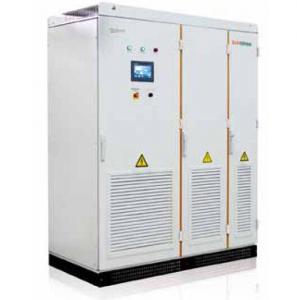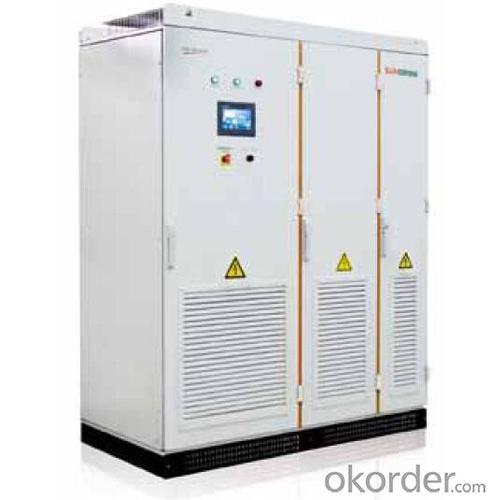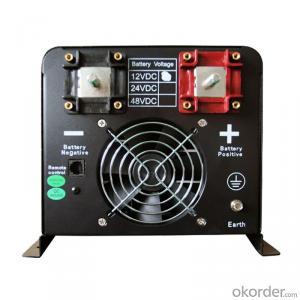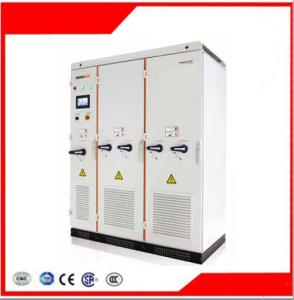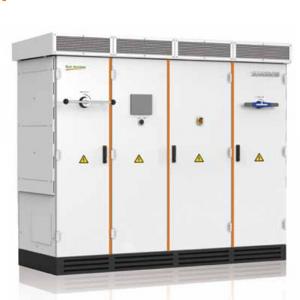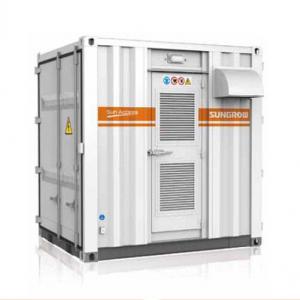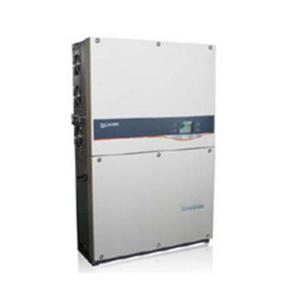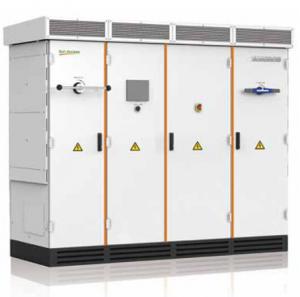Photovoltaic Grid-Connected Inverters SG630MX
- Loading Port:
- China Main Port
- Payment Terms:
- TT or LC
- Min Order Qty:
- 10 unit
- Supply Capability:
- 1000 unit/month
OKorder Service Pledge
OKorder Financial Service
You Might Also Like
1. Structure of Photovoltaic Grid-Connected Inverters SG630MX Description
SG630KTL is using low-frequency isolation transformer for protective purpose.
Its wider input voltage range ensures more combinations of the PV arrays.
Moreover, optical fiber isolation technology has been adopted to increase its anti-interference ability under the circumstances
of multiple inverters installation.
In addition, optimized circuit and structural design has improved system thermal efficiency which enhancing
system reliability and stability.
Reinforced protection functions, including the DC ground fault protection, make it the best product for large
scale PV power plant.
2. Main Features of the Photovoltaic Grid-Connected Inverters SG630MX
• CE certification, CGC certification
• LVRT (Zero-voltage Ride-through)
• Active power continuously adjustable (0~100%)
• Reactive power control with power factor from 0.9 lagging to 0.9 leading
• DC input voltage up to 1000V
• Latest 32 bit DSP chip, advanced digital lock-in technique, more quickly and precisely
• -30℃~+55℃ continuously operating at rated power
• Continuously and stably working in high altitude environment
• Auxiliary heater (Optional)
3. Photovoltaic Grid-Connected Inverters SG630MX Images

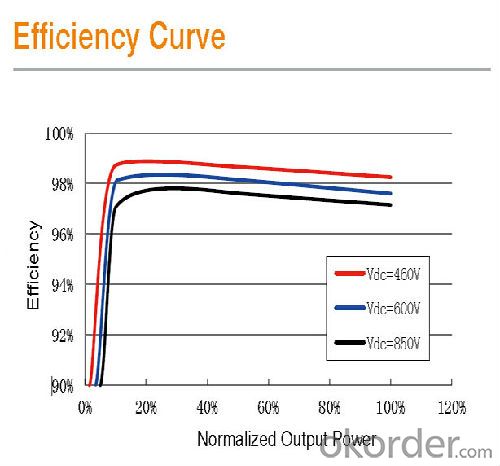

4. Photovoltaic Grid-Connected Inverters SG630MX Specification
MODEL | SG630MX-E |
DC SIDE DATA | |
Max. DC Voltage | 1000Vdc |
MPP Voltage Range | 615~850Vdc |
Max. DC Power | 7130kWp |
Max. Input Current | 1160A |
AC SIDE DATA | |
Rated Output Power | 630kW |
Rated Grid Voltage | 400Vac |
Grid Voltage Range | 250~362Vac |
Rated Grid Frequency | 50Hz/60Hz |
Grid Frequency Range | 47~52Hz/57~62Hz |
Output Current THD | <3% (at nominal power) |
DC Current Injection | <0.5% of rated inverter output current |
Power Factor | 0.9(lagging)~0.9(leading) |
SYSTEM | |
Max. Efficiency | 98.6% |
Euro Efficiency | 98.5% |
Protection Degree | IP21 |
Operating Temp. | -30~+65°C(> 55°C derating) |
Cooling Method | Temperature controlled forced-air cooling |
Relative Humidity | 0~95%, non-condensing |
Max. Working Altitude | 6000m (operation with derating above 3000m) |
Display AND COMMUNICATIONS | |
Display | touch screen LCD |
Standard Comm. Interfaces | RS485 |
Optional Comm. Interfaces | Ethernet |
MECHANICAL DATA | |
Dimensions(WxHxD) | 1606x2304x860mm |
Net Weight | 1700kg |
5. FAQ of Photovoltaic Grid-Connected Inverters SG630MX
Q1. What is the difference between inverter and solar inverter?
A1. Inverter only has AC inpput, but solar inverter both connect to AC input and solar panel, it saves more power.
Q2. What is the difference between MPPT&PWM?
A2. MPPT has higher efficiency, it can track the max power point and won't waste energy.
- Q: Can a solar inverter be connected to a battery storage system?
- Yes, a solar inverter can be connected to a battery storage system. This allows the excess energy generated by the solar panels to be stored in the battery for later use, providing backup power during times when the solar panels are not producing enough electricity.
- Q: Can a solar inverter be used with solar-powered streetlights?
- Yes, a solar inverter can be used with solar-powered streetlights. The solar inverter is responsible for converting the direct current (DC) produced by the solar panels into alternating current (AC) that can be used to power streetlights. This conversion allows the solar-powered streetlights to operate efficiently and effectively, utilizing the energy generated by the solar panels.
- Q: What is the role of a display interface in a solar inverter?
- The role of a display interface in a solar inverter is to provide real-time information and control options to the user. It allows the user to monitor the performance of the solar inverter, such as its power output, voltage levels, and error status. The display interface also enables the user to adjust settings, configure parameters, and troubleshoot any issues that may arise. Overall, it serves as a user-friendly tool for managing and optimizing the operation of the solar inverter system.
- Q: Can a solar inverter be used with a solar water pumping system?
- Yes, a solar inverter can be used with a solar water pumping system.
- Q: How do I monitor the performance of a solar inverter?
- To monitor the performance of a solar inverter, you can follow these steps: 1. Use a monitoring system: Many solar inverters come with built-in monitoring systems that provide real-time data on their performance. These systems often have user-friendly interfaces that allow you to easily track key metrics like energy production, voltage, and frequency. 2. Install a monitoring device: If your solar inverter doesn't have a built-in monitoring system, you can install an external monitoring device. These devices can be connected to the inverter and provide detailed performance data, which can be accessed through a dedicated software or app. 3. Track energy production: Keep a record of the energy produced by your solar inverter on a daily, weekly, or monthly basis. This will help you assess its performance over time and identify any potential issues or discrepancies. 4. Monitor key metrics: Monitor important metrics such as voltage and frequency to ensure that your solar inverter is operating within the desired parameters. Deviations from the expected values could indicate a problem that needs attention. 5. Set up alerts: Some monitoring systems or devices allow you to set up alerts for specific performance thresholds. This way, you will be notified if the inverter's performance falls below or exceeds certain limits, enabling you to take prompt action. 6. Regularly check for errors or alarms: Check the monitoring system or device for any error codes or alarms that indicate malfunctions or issues with the inverter. Addressing these problems early on can prevent further damage and optimize performance. By regularly monitoring the performance of your solar inverter, you can ensure its efficiency, detect potential problems, and maximize the energy output of your solar system.
- Q: How do you choose the right input voltage range for a solar inverter?
- When choosing the right input voltage range for a solar inverter, it is essential to consider the specifications and requirements of the specific solar panels being used. The input voltage range should be compatible with the voltage output of the solar panels to ensure optimal performance and efficiency. Additionally, factors such as the system size, installation location, and local regulations should also be taken into account to determine the appropriate input voltage range for the solar inverter.
- Q: What is the maximum efficiency rating of a solar inverter?
- The maximum efficiency rating of a solar inverter can vary depending on the model and manufacturer, but typically it ranges from 95% to 98%.
- Q: What is the temperature range for optimal operation of a solar inverter?
- The temperature range for optimal operation of a solar inverter typically falls between -20°C to 50°C.
- Q: What safety features should a solar inverter have?
- A solar inverter should have several safety features, including overvoltage protection, overcurrent protection, ground fault protection, and arc fault protection. Additionally, it should have robust insulation to prevent electrical shock hazards and be equipped with sensors to monitor temperature and prevent overheating. Finally, it should have a secure enclosure to protect against environmental factors such as water, dust, and debris.
- Q: Can a solar inverter be used with a single solar panel?
- Yes, a solar inverter can be used with a single solar panel. The purpose of a solar inverter is to convert the direct current (DC) generated by the solar panel into usable alternating current (AC) electricity. Whether you have one or multiple solar panels, a solar inverter is necessary to convert the DC power into AC power that can be used to power electrical appliances or be fed back into the grid.
Send your message to us
Photovoltaic Grid-Connected Inverters SG630MX
- Loading Port:
- China Main Port
- Payment Terms:
- TT or LC
- Min Order Qty:
- 10 unit
- Supply Capability:
- 1000 unit/month
OKorder Service Pledge
OKorder Financial Service
Similar products
Hot products
Hot Searches
Related keywords
